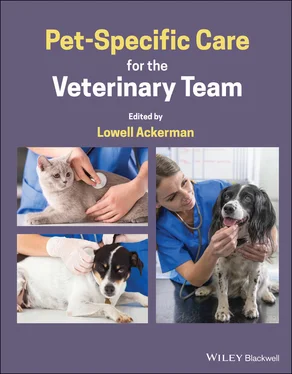Jack, a 13‐year‐old neutered male miniature schnauzer, visited ABC Animal Hospital for his semiannual senior preventive care exam two days ago. At that time, his senior laboratory work was drawn. For the past 10 years, Jack's urine has included some calcium oxalate crystals, but this latest test revealed 4+ crystals and Jack's abdomen had been somewhat tense on palpation. Concerned, the veterinarian calls Jack's owner with the results and recommends an ultrasound, informing her about the cost of the diagnostic test.
Jack's owner expresses concern over the price and asks if ultrasound is necessary. The veterinarian informs her that because Jack is showing other early signs of potential problems, and because urinary tract “stones” are common in the breed, she believes it is important to conduct the ultrasound to make a diagnosis so appropriate treatments can begin, if needed. Since Jack was not covered by pet health insurance, the doctor offered Jack's owner two options to help with upfront costs: a payment plan or third‐party financing.
Jack's owner trusts that her veterinarian is recommending the best diagnostic option, so she applies for third‐party financing, enabling her to make future monthly payments on Jack's veterinary care.
 TAKE‐AWAYS
TAKE‐AWAYS
Veterinarians need to be prepared to discuss cost of care with pet owners at the time recommendations are made.
When veterinarians are not transparent and upfront about the cost of care, pet owners lose trust in them, and support staff are left to handle the brunt of client frustrations.
Veterinarians should make recommendations based on what is best for pets, not what they think pet owners can afford.
If cost of care is a barrier, a veterinarian should offer payment assistance options rather than modifying the recommendations.
When veterinarians neglect to discuss price and alter their recommendations based on price objections, clients are more likely to question their motives, which can result in negative perception of the veterinary profession.
 MISCELLANEOUS
MISCELLANEOUS
References
1 1 Coe, J.B., Adams, C.L., and Bonnett, B.N. (2007). A focus group study of veterinarians' and pet owners' perceptions of the monetary aspects of veterinary care. Journal of the American Veterinary Medical Association 231 (10): 1510–1518.
2 2 Coe, J.B., Adams, C.L., and Bonnett, B.N. (2009). Prevalence and nature of cost discussions during clinical appointments in companion animal practice. Journal of the American Veterinary Medical Association 234 (11): 1418–1424.
3 3 American Animal Hospital Association (2018). The Veterinary Fee Reference, 10e. Lakewood, CO: AAHA Press.
4 4 Guzman, Z. Owning a pet can cost you $42,000, or 7 times as much as you expect. www.cnbc.com/2017/04/27/how‐much‐does‐it‐cost‐to‐own‐a‐dog‐7‐times‐more‐than‐you‐expect.html
2.10 Affordability of Veterinary Services
Patricia Khuly, VMD, MBA
Sunset Animal Clinic, Miami, FL, USA
 BASICS
BASICS
As more and more people embrace the perception of pets as family members, the veterinary profession has worked hard to meet the needs of a more demanding audience of veterinary caregivers. To wit, the veterinary industry's principal reaction to our pets' elevated status has been to make its service offerings more sophisticated and raise the overall standard of care.
This cultural shift and the resulting veterinary advancements, while welcome, have had some unintended consequences. Most notably, these otherwise agreeable trends have unearthed an acute tension between veterinary professionals and the pet owners whose desire to treat their pets like family may outstrip their ability to pay for the veterinary care available to them.
 MAIN CONCEPTS
MAIN CONCEPTS
The escalating discrepancy between emotionally invested owners and the higher cost of advanced veterinary medicine has been widely characterized by industry analysts as an affordability crisis. The primary concern is that as the gap between veterinary cost and ability to pay widens, a lower percentage of pets will receive the treatments the industry has prepared for them.
Despite a rise in pet ownership, the overall number of veterinary visits has dropped, driving speculation that veterinary care may be increasingly unattainable for pet owners at the lower end of the economic spectrum [1].
At risk is not just the veterinarian–client–patient relationship the profession has meticulously nurtured over the past several decades, but the wider industry itself. Should mounting affordability concerns lead future generations of pet owners to adopt a more adversarial attitude toward veterinary medicine – or, worse, a dismissive one – the industry stands to lose more than just the reputation of its veterinarians. Nothing less than the profession's future economic viability is at stake.
Further, it is clear that affordability represents an existential threat to the veterinary profession's moral fabric. When the veterinarian's oath pledges to “promote animal health and welfare, relieve animal suffering, [and] protect the health of the public,” it cannot equitably and ethically do so if it incommensurately serves the needs of the most affluent, educated or dedicated pet owners.
To examine the issues involved in more detail, it serves to categorize the relevant concerns as flowing from the demand side versus the supply side. Primary affordability factors affecting the demand for veterinary services include the following.
Pet keeping is expensive and overall pet costs are on the rise, which can make healthcare (especially of “healthy” animals) a lower priority. Indeed, the average pet owner spends more than ever before on their pets' nutrition, effectively lowering the percentage of income available for veterinary expenses.
Higher income pet owners expect higher quality healthcare. For this segment of the population, the notion of pets as family means they are willing to dedicate extraordinary sums to their pets' healthcare. This fuels much of the progress in veterinary medicine.
Income inequality: as the gap between rich and poor widens, more and more veterinary patients are priced out of veterinary services altogether. This despite the fact that pet keeping appears to have increased roughly proportionately across all income levels.
Pet owners enjoy a greater emotional attachment to their pets than in previous generations, effectively increasing a pet's overall value to the household. Given that pet care costs are similar for all pets, lower income owners spend a disproportionately larger percentage of their earnings on them.
Wellness aversion: for a variety of reasons, lower income pet owners tend to eschew wellness services preferentially. This only exacerbates affordability concerns given that emergent services are innately more expensive, typically unplanned, often delivered by secondary care centers, and more likely to be required when routine care is forgone.
Читать дальше

 TAKE‐AWAYS
TAKE‐AWAYS MISCELLANEOUS
MISCELLANEOUS BASICS
BASICS MAIN CONCEPTS
MAIN CONCEPTS










